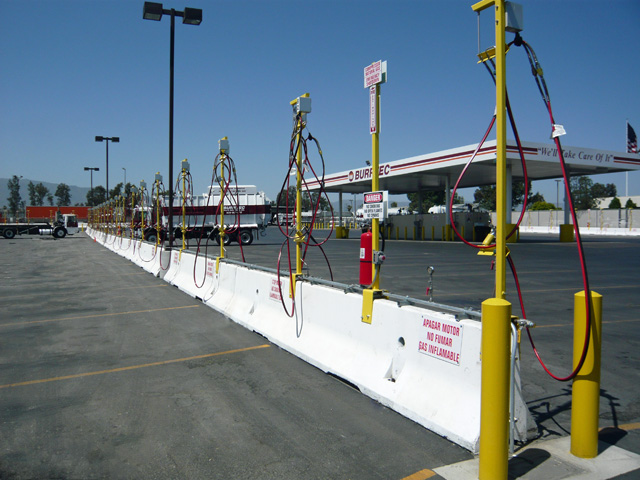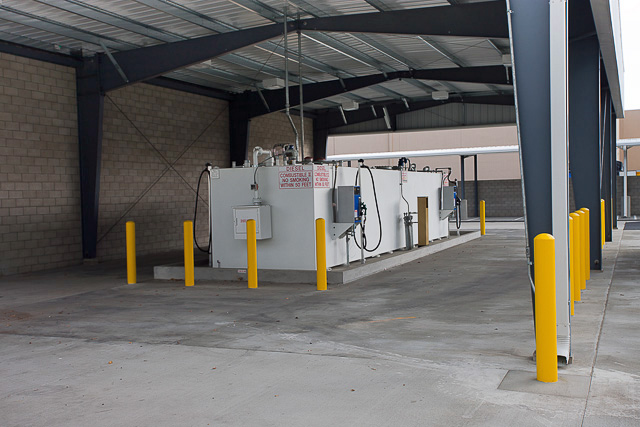Constructing Natural Gas Filling Stations
Building natural gas filling stations is an exciting way for a general contractor to participate in this eco-friendly alternative energy trend. Because natural gas filling stations have only recently come on the scene, each construction project involving them seems to encounter some new aspect or previously unseen characteristic. The main concerns for the project owner have to do with choosing the type of fueling method, settling on the number of stations and general layout.

The construction of natural gas stations has to be tailored to the nature of vehicle or vehicles they are designed to serve. In some cases it involves retrofitting an existing station, contractually similar to making tenant improvements or renovations. In other instances the construction is entirely new.
There is a wide range of vehicle types that have been converted to run on CNG. Examples are municipal vehicles, light duty trucks, school buses and forklifts. Common CNG filling station installations are privately owned facilities utilized for the refueling of their company fleets. The public also needs to be served; individual owners of cars and trucks converted to operate on natural gas require access to refueling stations.
 When a commercial operation has chosen to provide public access to its CNG facility, it is sometimes on an exclusive basis and sometimes as an augmentation to its own private uses. This public/private dichotomy is distinctive of most alternative energy supply facilities, including EV charging stations, due to their relative scarcity compared to gas stations. This is yet another variation of which the contractor needs to be aware.
When a commercial operation has chosen to provide public access to its CNG facility, it is sometimes on an exclusive basis and sometimes as an augmentation to its own private uses. This public/private dichotomy is distinctive of most alternative energy supply facilities, including EV charging stations, due to their relative scarcity compared to gas stations. This is yet another variation of which the contractor needs to be aware.
There are two types of filling method available for compressed natural gas: the time-fill method, which is designed to occur overnight, taking five to eight hours, and the fast-fill method, which is similar in behavior to a gasoline pump, taking but minutes. Station owners have to consider the needs of their customers in deciding how many of each filling type to order. (The time-fill method is appropriate for private fleets, whereas fast-fill is more appropriate for public and/or spontaneous purposes.)
Obviously, for any given number of vehicles, more time-fill stations are needed than fast-fill, and thus the owner's decisions have an impact on station capacity, design and layout. These attributes in turn influence the contractor's approach to the project. He has to visit the site to determine the location and other characteristics of the tank as well as to assess how the owner's plan can best be realized.
It is important for the owner and the general contractor to discuss at length additional technical specifications involved in constructing natural gas stations. For instance, there may be the requirement to keep track of the fuel amount used by each individual vehicle (for a variety of reasons including billing). If so, this changes the nature of the equipment and typically requires the driver to carry an access card.
Other technical measurements that have to be done include natural gas pressure at the given location and gas quality. The latter number is used to determine moisture content in the local gas, which will in turn be used to calibrate the inlet dryer (a moisture removal tool) if needed. The nature of electrical service, local building code requirements and the permitting process are other concerns to be discussed between contractor and owner.
Facility Builders has already established itself as a leader in managing and delivering natural gas station projects. Our expertise in obtaining LEED certification and in green buildings helps to keep us in the forefront of environmentally friendly construction solutions. We have demonstrated the flexibility needed to consider objectively a range of options and to help the customer make the right choices. If conversion to this fuel is in store for you, give Facility Builders & Erectors a call.